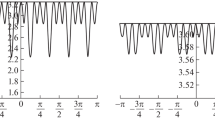Abstract
This paper is concerned with the problem of constructing R-optimal designs for trigonometric regression models with different orders. More precisely, explicit R-optimal designs for the first-order trigonometric regression model on a partial cycle are derived by using the idea of complete class approach. The relative R-efficiency of the equidistant sampling method is then discussed. Moreover, when the explanatory variable varies in a complete cycle, the R-optimal designs for estimating the specific pairs of the coefficients in the trigonometric regression of larger order are obtained by invoking the equivalence theorem. Several examples are presented for illustration.






Similar content being viewed by others
References
Currie AJ, Ganeshanandam S, Noition DA, Garrick D, Shelbourne CJA, Oragguzie N (2000) Quantiative evalution of apple (Malus \(\times \) domestica Borkh.) fruit shape by principle component analysis of Fourier descriptors. Euphytica 111:219–227
Dette H (1997) Designing experiments with respect to ‘standardized’ optimality criteria. J R Stat Soc Ser B 59:97–110
Dette H, Melas VB, Pepelysheff A (2002) \(D\)-optimal designs for trigonometric regression models on a partial circle. Ann Inst Stat Math 54:945–959
Dette H, Melas VB (2003) Optimal designs for estimating individual coefficients in Fourier regression models. Ann Stat 31:1669–1692
Dette H, Melas VB, Shpilev P (2009) Optimal designs for estimating pairs of coefficients in Fourier regression models. Stat Sin. 19:1587–1601
Dette H, Melas VB, Shpilev P (2011) Optimal designs for trigonometric regression models. J Stat Plan Inference 141:1343–1353
He L, Yue R-X (2017) R-optimal designs for multi-factor models with heteroscedastic errors. Metrika 80:717–732
Hill PDH (1978) A note on the equivalence of D-optimal design measures for three rival linear models. Biometrika 65:666–667
Karlin S, Studden WJ (1966) Tchebycheff systems: with applications in analysis and statistics. Interscience, New York
Kiefer J (1974) General equivalence theory for optimum designs (approximate theory). Ann Stat 2:849–879
Kitsos CP, Titterington DM, Torsney B (1988) An optimal design problem in rhythmometry. Biometrics 44:657–671
Kutner M, Nachtsheim C, Neter J, Li W (2005) Applied linear statistical models, 5th edn. McGraw-Hill/Irwin, New York
Lau TS, Studden WJ (1985) Optimal designs for trigonometric and polynomial regression. Ann Stat 13:383–394
Liu X, Yue R-X (2013) A note on \(R\)-optimal designs for multiresponse models. Metrika 76:483–493
Liu X, Yue R-X, Chatterjee K (2014) A note on \(R\)-optimal designs for multi-factor models. J Stat Plan Inference 146:139–144
Liu X, Yue R-X, Xu J, Chatterjee K (2016) Algorithmic construction of \(R\)-optimal designs for second-order response surface models. J Stat Plan Inference 178:61–69
Lestrel PE (1997) Fourier descriptors and their applications in biology. Cambridge University Press, Cambridge
McCool JI (1979) Systematic and random errors in least squares estimation for circular contours. Precis Eng 1:215–220
Paulus I, Schrevens E (1999) Shape characterization of new apple cultivars by Fourier expansion of digitized images. J Agric Eng Res 72:113–118
Pukelsheim F (1993) Optimal design of experiments. Wiley, New York
Rao CR (1968) Linear statistical inference and its applications. Wiley, New York
Wu H (1997) Optimal exact designs on a circle or a circular arc. Ann Stat 25(5):2027–2043
Wu H (2002) Optimal designs for first-order trigonometric regression on a partial circle. Stat Sin 12:917–930
Xu X, Shang X (2014) Optimal and robust designs for trigonometric regression models. Metrika 77(6):753–769
Xu X, Shang X (2017) \(D\)-optimal designs for full and reduced Fourier regression models. Stat Pap 58:811–829
Young JC, Ehrlich R (1977) Fourier biometrics: harmonic amplitudes as multivariate shape descriptors. Syst Zool 26:336–342
Zhang C-H, Zhang SS (2014) Confidence intervals for low dimensional parameters in high dimensional linear models. J R Stat Soc Ser B 76:217–242
Author information
Authors and Affiliations
Corresponding author
Additional information
This work was supported by NSFC Grant 11471216
Rights and permissions
About this article
Cite this article
He, L., Yue, RX. R-optimal designs for trigonometric regression models. Stat Papers 61, 1997–2013 (2020). https://doi.org/10.1007/s00362-018-1017-x
Received:
Revised:
Published:
Issue Date:
DOI: https://doi.org/10.1007/s00362-018-1017-x




